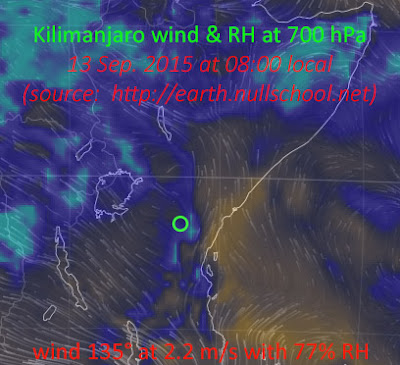Here is another view of the constantly-changing clouds we watched
September 13th on Kibo, ascending from Karanga to Barafu Camp (see
below or here for the image posted last week).
According to our Northern Ice Field AWS measurements that morning, wind speeds were rather modest at the time (~7
m/s); data from NCEP (see below) agree reasonably well. The image above suggests a sharp boundary between small parcels of
air with contrasting moisture content, and as shown by the image below -
with Kibo's location indicated by the green circle - humidity at 500 hPa
(summit level) was variable that
morning. The humidity contrast is even more pronounced at the 700 hPa level (see image; brown color is less than approx. 20%, cyan blue is greater than ~95%). Although wind speeds were low by all measures, direction varied with altitude. We were watching cream be added to coffee, in slow motion.
The spell-binding display we witnessed was no doubt the result of numerous interacting factors, in addition to these. Mountain fieldwork is always interesting!
One additional image showing NCEP humidity data follows. Note the high
humidity (blue) at 500 hPa over a broad area around Kilimanjaro.
Interestingly, my field notes early that morning read: "Humidity
increased during the night; the air feels and smells different, and both
sides of the tent fly are frosty. Sky clear." Later that afternoon we
experienced a snow squall which blanketed the summit crater with ~5 cm
of new snow (image 5, previous post), our only precipitation of the expedition.
Tuesday, September 29, 2015
Subscribe to:
Post Comments (Atom)







No comments:
Post a Comment